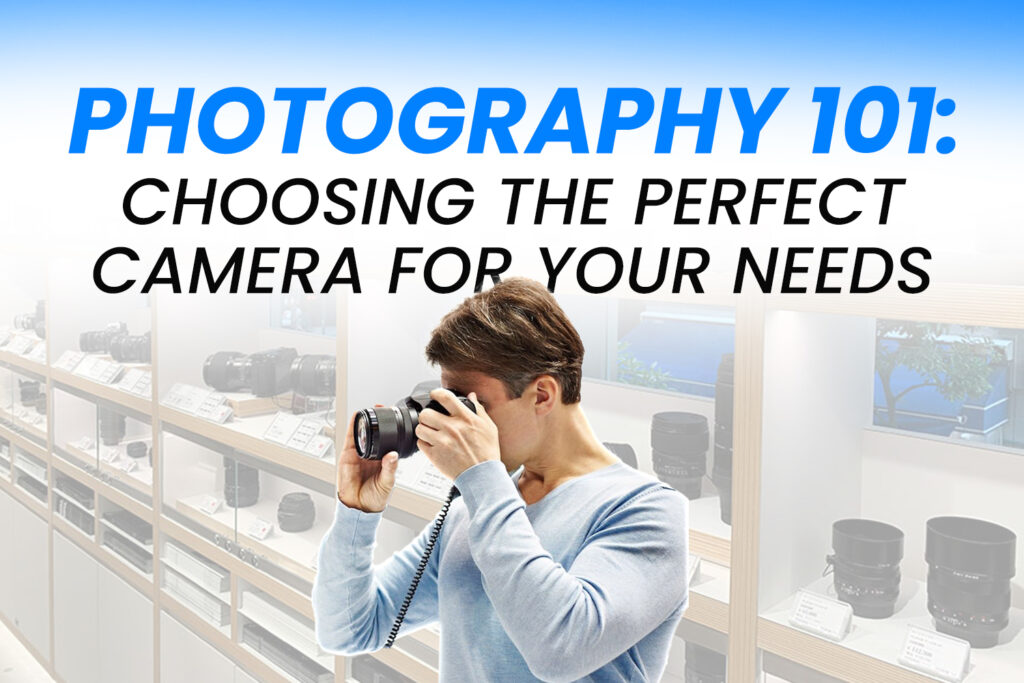Important specifications to check out when buying a camera are autofocus speed, frames per second (fps), startup time, and overall operational speed ratings on B Store. The fps rating is the number of photos, shots, or frames that a camera can capture per second. Higher fps ratings offer smoother and clearer images or video. Choosing the perfect camera for your photography needs depends on various factors such as your budget, intended use, preferred features, and level of expertise.
Here’s a simplified guide to help you make an informed decision:
To take a great photo, you need to understand the four essential elements of photography: composition, aperture, shutter speed, and ISO. Each of these elements affects your photo differently, and understanding how they work together is the key to taking great pictures. Determine, for what you’ll primarily use the camera. Are you interested in casual photography, professional work, travel, sports, portraits, landscapes, or something else?
Define Your Budget:
Set a realistic budget. Cameras come in a wide price range on B Store, from affordable point-and-shoots to high-end professional DSLRs and mirrorless cameras. Determine how much you’re willing to spend on a camera and any additional accessories like lenses, memory cards, and camera bags. If you know your range is to customize their packages, adjust package items to make them fit, or suggest things that matter to you most based on your needs.
Identify Your Photography Needs:
Consider what type of photography you’ll primarily be doing. Are you into portraits, landscapes, wildlife, sports, or macro photography? Different genres may require specific features and equipment.
Think About Ergonomics and User Interface: A camera that feels comfortable to hold and navigate will make your shooting experience more enjoyable. Ensure the camera’s controls and menu system are intuitive and comfortable for you to use. Some cameras offer touchscreen interfaces, which can be more user-friendly.
Resolution: Higher megapixels don’t always mean better image quality. Consider how you’ll use your photos. For most purposes, anything above 10-12 megapixels is sufficient.
Lenses: If you opt for a DSLR or mirrorless camera, consider the available lenses. The lens selection can significantly impact your photography options.
Consider Portability: The Olympus Stylus Epic Zoom is a compact and versatile point-and-shoot film camera that has garnered attention for its portability, ease of use, and quality performance.
Select a Camera Type: There are several types of cameras to choose from:
- DSLR (Digital Single-Lens Reflex): Known for their versatility, excellent image quality, interchangeable lenses, optical viewfinders, and advanced features. Ideal for enthusiasts and professionals who prioritize versatility and control.
- Point-and-Shoot: Simple to use, compact, and usually budget-friendly. Great for beginners or casual photographers.
- Mirrorless: Similar image quality and features to DSLRs but compact and lightweight with interchangeable lenses, electronic viewfinders, and advanced autofocus systems. They’re becoming increasingly popular due to their compact size and advanced technology.
- Compact: Portable and easy to use, great for casual photography and travel.
- Medium Format: High-end cameras with larger sensors for unparalleled image quality, typically used by professional photographers.

Consider Future Expansion: If you’re investing in a camera system, think about the availability of compatible lenses and accessories, as well as the brand’s ecosystem.
Camera Features:
- Sensor Size: Larger sensors generally produce higher image quality, especially in low-light conditions.
- Megapixels: More megapixels don’t always equate to better image quality but can be beneficial if you plan to print large photos or crop heavily.
- Autofocus System: Look for cameras with fast and accurate autofocus systems, especially if you shoot fast-moving subjects.
- Image Stabilization: Helps reduce blur caused by camera shake, particularly useful in low light or when using telephoto lenses.
- Video Capabilities: If you plan to shoot videos, consider cameras with 4K recording, microphone inputs, frame rates, and good autofocus during video recording.
- Connectivity Options: Wi-Fi, Bluetooth, and NFC connectivity allow for easy sharing and remote control of the camera.
- Weather Sealing: Important if you plan to shoot in challenging weather conditions.
- ISO Range: Higher ISO allows for better low-light performance, but too high can introduce noise into your images.
- Shooting Speed: Consider the camera’s frames per second (fps) for capturing fast-moving subjects like sports or wildlife.
Try Before You Buy: Visit a camera store if possible and test out different models to see how they feel in your hands and how intuitive are their controls.
Factor in Long-Term Costs: Remember to budget for additional lenses, batteries, memory cards, and other accessories that you may need down the line.
Research and Read Reviews: Look up online reviews and comparisons of the cameras you’re interested in to get a better understanding of their performance and reliability. Read reviews from reliable sources and seek recommendations from experienced photographers.
Overall
With practice and patience, you can create stunning, professional-looking photos that truly capture the essence of your subject. Take time to find your niche, and what you enjoy. Don’t beat yourself up that your images aren’t wonderful the first time.


